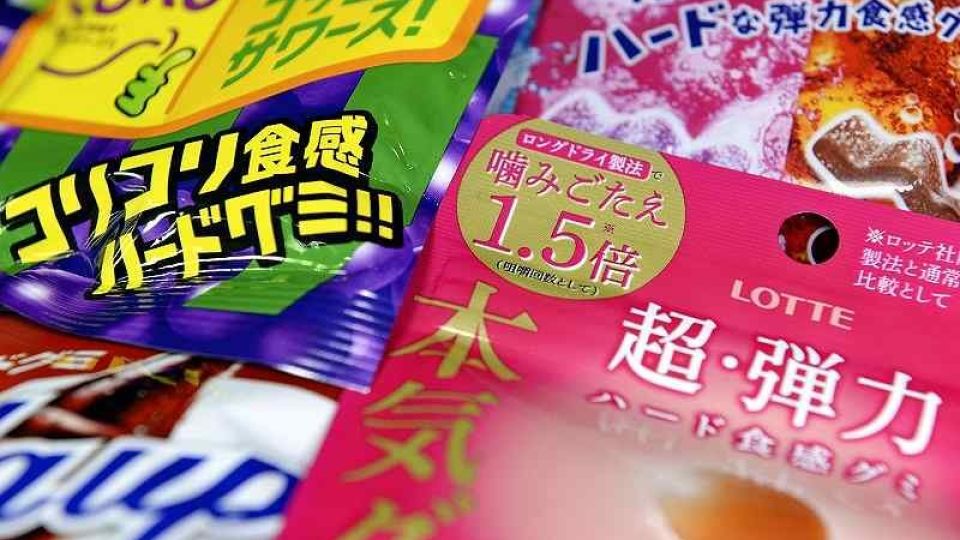January 5, 2023
TOKYO – Convenience stores and supermarkets have increasingly put a certain type of candy on their shelves: gummies.
The word “gummy” evokes an image of a soft sweet for children, but other words, such as “hard” and “chewy,” have now become conspicuous on their packages.
The world’s first gummy product is said to have been created by the Haribo company, which is most famous for its bear-shaped candy in Germany in the 1920s. Haribo gummies began to be imported to Japan in 1985.
Japan’s first domestically produced gummy candy is said to be the cola-flavored Colaup, launched in 1980 by Meiji Seika, which has since been incorporated into the Meiji Group. In 2021, annual sales of gummy products surpassed those of chewing gum for the first time.

Various flavors, colors and shapes of gummies are displayed on the shelves at the Mega Don Quijote Shibuya main store in Shibuya Ward, Tokyo. The Yomiuri Shimbun
At the Mega Don Quijote Shibuya main store, a flagship store of major discount store chain Don Quijote in Tokyo, about 300 kinds of gummy products fill the confectionery shelves, with signs reading, “Which do you prefer?” and “Hard vs Soft.” Many gummy products are adorned with words describing their texture, such as “high elasticity” and even “crunchy.”
“As the number of products has increased, offering a variety of tastes, colors and textures, gummy candies have grown more popular by attracting the attention of a wide range of people,” said a source at the retailer.
A 36-year-old gummy candy fan who provides information on gummy products on his blog, called “Blogummy,” said, “I like gummies that need to be bitten 10 to 15 times to chew through, as well as those that have strong resistance but the flavor slowly seeps out.”
The blogger has reviewed more than 450 gummy products so far. He said the harder a gummy is, the more it helps him concentrate. When it’s time to get down to serious work, he puts his favorite hard-texture gummies into his mouth.
“I feel comfortable when chewing and gnawing on them,” he said. “I can’t do things without them when I also work remotely.”
Food companies are also applying their ingenuity to gummy innovation.
Tokyo-based Meiji Co. analyzes the hardness of gummy candies using its own experimental equipment. In 2021, the company began displaying the hardness of gummies on a six-level scale on products’ packages. The higher the number, the harder the gummy is. The hardest, 5+, is said to be more than twice as chewy as the company’s Juicy Gummy signature product, which has a hardness factor of 2.
The 5+ products have been marketed with the slogan, “For when you are frustrated.” The hard gummies appear to play a role in helping people deal with the stresses of modern life.
In the spring last year, UHA Mikakuto Co., a confectioner based in Osaka, released a new product called Hagane (steel), in its Ninja Meshi gummy series. The product is characterized by its hard, rubbery texture that is not easy to chew through.
“It’s popular mainly among men in their 20s and 30s. Some people buy the gummies in bulk, saying they are addictive,” a person at the company said.
Why hard gummies?
“For creatures with teeth, chewing is a fundamental need,” said Yuji Wada, a Ritsumeikan University professor specializing in psychology. “Humans have the nature of seeking stronger stimulation once they become accustomed to [a certain level of] it, so they may be attracted to harder gummy candies.”
Akio Nozawa, a professor of sensing engineering at Aoyama Gakuin University, said, “It is known that chewing increases blood flow to the brain and promotes the secretion of serotonin, called the ‘happy hormone.’”
According to Nozawa, some studies have shown that chewy gummies improved psychological comfort. “The synergistic effect with the comfort of good taste may have a positive impact both on the mind and physiology,” he said.
Chewing gum also requires chewing, but people have tended to shun gum since the novel coronavirus pandemic ushered in an era of universal mask-wearing, as gum is meant to be removed from the mouth for disposal. Instead, gummies have become popular.
“Chewing hard food is thought to improve saliva secretion and muscle strength around the mouth,” said Ichiro Saito, a dentist and a former professor at Tsurumi University. “Demand [for gummies] might increase among people such as the elderly.”
Gummies turn into drinks, snacks

Drinks and snacks made with gummy candies recommended by the chairperson of the Japan Gummy Association: lemonade cider, left, beer cocktail, back, and caprese-style snacks.The Yomiuri Shimbun
Drinks and snacks made from gummies have also caused a buzz on the internet. The chairperson of the Japan Gummy Association, which comprises gummy lovers, recommended the following three ways to enjoy gummies.
Lemonade cider can be made by heating a small amount of lemon-flavored gummies in a microwave oven, then adding them to a glass with chopped gummies and soda water. The subtle sweetness and texture of the gummies offer a different aspect of the candy.
For adults, a beer cocktail, for which your favorite gummies are mixed with beer, is also recommended.
Snacks in a caprese style can be also made by rolling up a piece of prosciutto ham and skewering it with citrus-based gummies and cheese. They can also be garnished with tomatoes and olive oil.
“Gummy candies are easy to handle when used as if they were fruits. I want people to enjoy them with a free spirit,” the chairperson said.

